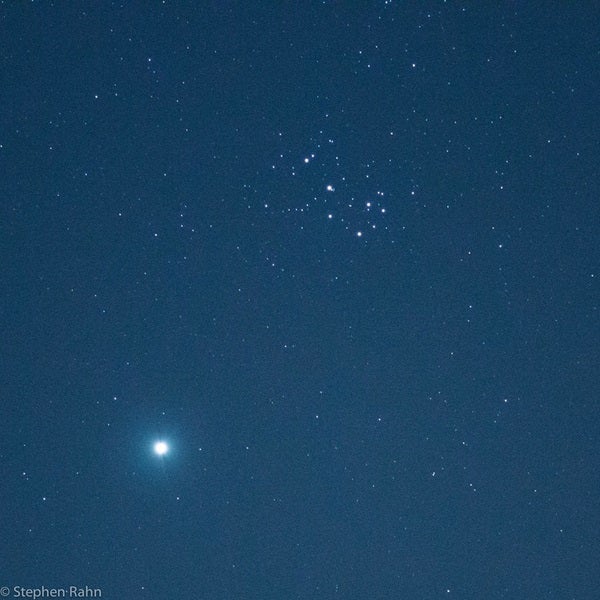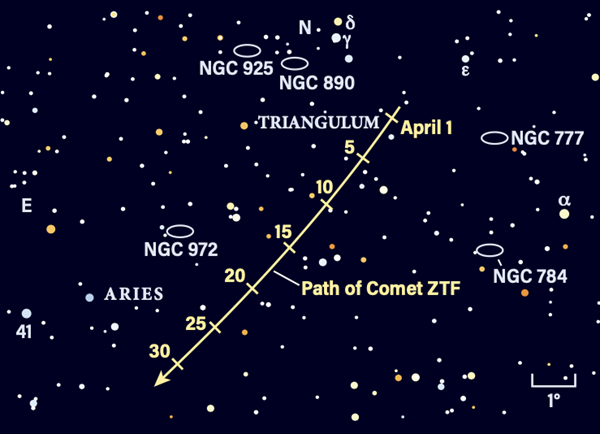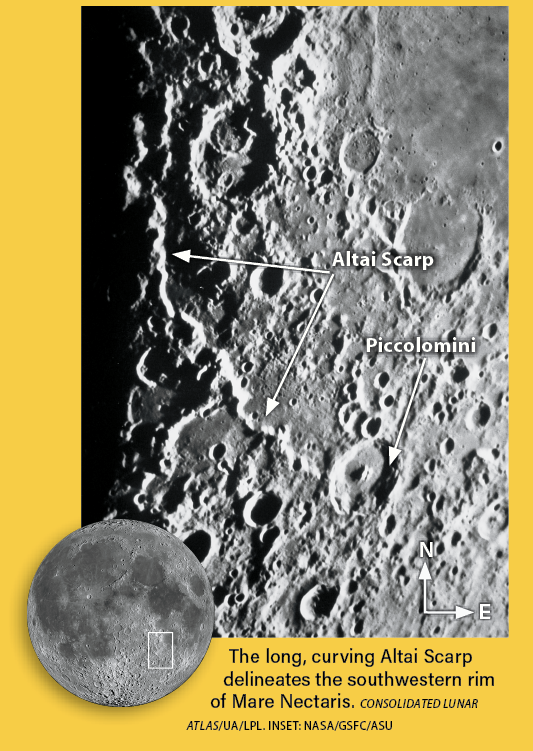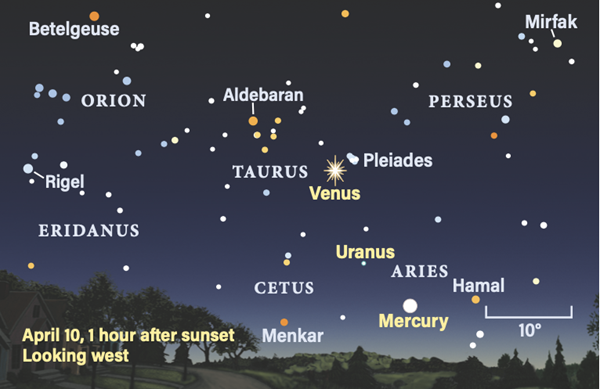
Bright planets hang in the west and Last Quarter Moon shines from April 7 to 14.
Friday, April 7
M44, also popularly known as the Beehive Cluster and, more historically, Praesepe (the manger), is a young open cluster in the center of Cancer the Crab. This constellation is already crawling high in the south an hour after sunset, nestled between Gemini the Twins to the west and Leo the Lion to the east.
Spanning nearly 100′, M44 glows at 4th magnitude, rendering it visible to the naked eye in a dark sky. Eagle-eyed observers have reported resolving at least a few of its brightest stars without optical aid. If you need a little guidance to find the cluster, first look for bright Regulus in Leo the Lion. Some 17° due west of that star is 4th-magnitude Acubens, Cancer’s alpha star. North-northeast of Acubens is 4th-magnitude Delta (δ) Cancri, some 7° away. Simply extend the line between Acubens and Delta another 2° in the same direction and you’ll land right in the midst of M44.
Binoculars should net you about 40 stars; a telescope will pull out even more. In all, astronomers believe M44 contains about 1,000 stars, though most are too dim to spot through amateur instruments.
Sunrise: 6:35 A.M.
Sunset: 7:31 P.M.
Moonrise: 9:24 P.M.
Moonset: 7:18 A.M.
Moon Phase: Waning gibbous (98%)
*Times for sunrise, sunset, moonrise, and moonset are given in local time from 40° N 90° W. The Moon’s illumination is given at 12 P.M. local time from the same location.

Saturday, April 8
With the Moon now absent from the sky for several hours after sunset, tonight marks the start of your chance to view Comet C/2020 V2 (ZTF). Currently around magnitude 10, ZTF is just 10° above the northwestern horizon some 90 minutes after sunset. It lies in the small constellation Triangulum, just over 5° east of magnitude 3.4 Alpha (α) Trianguli. Alternatively, you can drop about 3.5° due south of 4th-magnitude Gamma Trianguli to reach the comet.
Once you’re in the vicinity, look for a slightly lopsided parallelogram of field stars; this lies just west of ZTF’s fuzzy coma. Because ZTF is dim, you’ll want a larger scope and a darker sky to find it. Try to get away from any light pollution and put yourself higher than your surroundings for the best vantage point. ZTF is currently approaching the Sun for its perihelion in a month’s time, but because even its closest point to our star lies beyond the orbit of Mars, it won’t light up spectacularly.
Several galaxies also reside in this region, offering additional viewing targets while you’re in the area. They also provide a nice visual comparison with the comet. The 11th-magnitude spiral galaxy NGC 972, which lies 4° east of the ZTF tonight and is just over the border in Aries, is a particularly nice option to compare against your impression of ZTF.
Sunrise: 6:33 A.M.
Sunset: 7:32 P.M.
Moonrise: 10:34 P.M.
Moonset: 7:45 A.M.

Sunday, April 9
The waning gibbous Moon dominates the early-morning sky, showing off most of its Earth-facing side. In the lunar southeast, you’ll notice the bright, rayed crater Tycho still prominent.
Slide your attention northeast from that crater to where the lunar surface just begins to disappear into the shadow of night. There, you’ll spot the smaller dark, round blotch of Mare Nectaris (the Sea of Nectar). Its southwestern edge is marked by the shallow crater Fracastorius, whose northern rim is missing so that its boundary blurs with that of Nectaris.
But this isn’t the true rim of Mare Nectaris. Look a little further southwest and you’ll notice the long, curving Altai Scarp. This is the sea’s real southwestern rim; now look back toward Nectar’s center and you’ll see how much larger this structure truly is. The southeastern portion of Altai disappears into the small crater Piccolomini, which boasts an easy-to-spot central peak.
Sunrise: 6:31 A.M.
Sunset: 7:33 P.M.
Moonrise: 11:46 P.M.
Moonset: 8:18 A.M.
Moon Phase: Waning gibbous (87%)

Monday, April 10
Magnitude –4 Venus blazes in the west at sunset, visible even while the sky remains light. An hour after the Sun sinks below the horizon, the twilight has deepened and Venus now hangs like a stunning jewel just to the lower left (south) of the Pleiades star cluster (M45) in Taurus. It’s a gorgeous pairing that can be enjoyed for several hours, finally sinking out of sight shortly after 10:30 P.M. local time.
Through a telescope, you’ll see that Venus’ 15″-wide disk is 74 percent lit, its eastern half in deep shadow. Nearby, the Pleiades are best viewed at low power through binoculars or even your finder scope. Because this cluster is so close to us — just 445 light-years distant — it spans almost 2° on the sky, meaning all its stars can’t fit within a highly magnified field of view. Take away any optical aid and see whether you think the naked-eye sight of the stars looks like a tiny dipper. Some skygazers think this is the Little Dipper when just starting out because of this shape; the true Dipper lies in the north and covers a much larger area of the sky.
If you step out particularly early in the evening, you’re likely to also catch magnitude –0.2 Mercury, which sits closer to the horizon and sets within two hours of the Sun. We’ll focus here tomorrow, when the solar system’s smallest planet reaches its greatest eastern elongation.
Sunrise: 6:30 A.M.
Sunset: 7:34 P.M.
Moonrise: —
Moonset: 8:58 A.M.
Moon Phase: Waning gibbous (79%)
Tuesday, April 11
Jupiter is in conjunction with the Sun at 6 P.M. EDT. This position renders it invisible all month.
So today, our focus is Mercury, which reaches greatest eastern elongation 19° east of the Sun also at 6 P.M. EDT. Shortly after the Sun disappears this evening, step outside and look west to see if you can spot the innermost planet. Now magnitude –0.1, Mercury stands just over 10° high 30 minutes after sunset.
Through a telescope, Mercury is 8″ wide and appears just under 40 percent lit. The planet will quickly begin fading from night to night, though it will remain in the evening sky for most of the month. Toward the end of April, it will “fall” back toward the Sun and, in addition to fading significantly, will also set earlier each night as it heads for inferior conjunction May 1.
Tonight, though, Mercury is in Aries and not far from another planet: Dim, distant Uranus also sits within the Ram’s borders, just less than 1° east of Mercury. Because the sky will still be bright while Uranus is visible, its magnitude 5.9 glow will be impossible to spot with the naked eye. Instead, use binoculars or a small telescope to slide just east of Mercury. Your best bet is to wait for twilight to deepen, but this also means the planets will be lower when you go looking. If possible, get to higher elevation to boost your chances of catching the ice giant in your eyepiece.
Sunrise: 6:28 A.M.
Sunset: 7:35 P.M.
Moonrise: 12:56 A.M.
Moonset: 9:49 A.M.
Moon Phase: Waning gibbous (69%)
Wednesday, April 12
Canes Venatici the Hunting Dogs is a circumpolar constellation close to the North Celestial Pole. Its two brightest stars lie south of the curve in the Big Bear’s elongated tail (also drawn as the handle of the Big Dipper). Magnitude 2.8 Cor Caroli (Alpha Canum Venaticorum) is some 17.5° due south of Alioth (Epsilon [ε] Ursae Majoris), the third star in from the end of the Big Dipper’s handle. Through a telescope, the star splits into a beautiful binary star with components nearly 20″ apart. The more luminous sun is blue-white, while its dimmer companion shines with a yellowish hue.
Cor Caroli also serves as a jumping-off point tonight for our second target: Upgren 1, some 5° southwest of this star. Cataloged in 1963, Upgren 1 looks a bit like a small triangle of stars through binoculars or a small scope. Though originally believed to belong together as a cluster, these stars are not truly associated and instead are a chance superposition. This makes Upgren 1 an asterism rather than a true cluster.
Sunrise: 6:27 A.M.
Sunset: 7:36 P.M.
Moonrise: 2:01 A.M.
Moonset: 10:51 A.M.
Moon Phase: Waning gibbous (58%)
Thursday, April 13
Last Quarter Moon occurs at 5:11 A.M. EDT. This lunar phase rules the early-morning sky, offering an enjoyable sight in the hour before sunrise. You don’t need binoculars or a telescope to get a good look at the Moon, though you can feel free to pull out some optics for a closer look at the rugged lunar surface.
Also visible in the morning sky is Saturn, climbing above the horizon in the east. An hour before sunrise, the ringed planet is nearly 10° high and rising. At magnitude 0.9, it will be visible to the naked eye until the sky grows too light, floating in the relatively sparse region of southwestern Aquarius.
For this target, you’ll definitely want to pull out a telescope if you have one. The planet’s disk spans some 16″, while its rings stretch more than double that. You may also spot Saturn’s largest and brightest moon, Titan, far west of the planet, sitting some 2.5′ away. The moon will reach its greatest western elongation from Saturn early tomorrow morning.
Sunrise: 6:25 A.M.
Sunset: 7:37 P.M.
Moonrise: 2:56 A.M.
Moonset: 12:01 P.M.
Moon Phase: Waning crescent (46%)

Friday, April 14
The Red Planet steals the spotlight tonight as it skims past the bright star Mebsuta (Epsilon Geminorum) in Gemini the Twins tonight.
Wait until the sky grows dark before looking west to find them. Mars glows at magnitude 1.1 and, together with Mebsuta, still stands about 40° high around 10 P.M. local time. Mebsuta’s modest apparent magnitude of 3.1 betrays a distant star that shines with an intrinsic luminosity some 7,600 times that of our own Sun.
Mars sits just 15′ (1/4°) from the star tonight, or roughly half the width of the Full Moon. You should be able to easily capture both in either binoculars or a telescope. Although Mars passes by Mebsuta without obscuring it, the planet (or others) does sometimes cross directly in front of this star from our point of view. When such an occultation happens, it’s a fantastic opportunity to study characteristics like the planet’s size, atmospheric composition, and any rings or moons it might have.
Much closer to the horizon and to the pair’s lower right this evening is bright Venus, now about 5° east of the Pleiades (M45) after its close pass to the cluster earlier this week.
Sunrise: 6:24 A.M.
Sunset: 7:38 P.M.
Moonrise: 3:42 A.M.
Moonset: 1:17 P.M.
Moon Phase: Waning crescent (35%)










